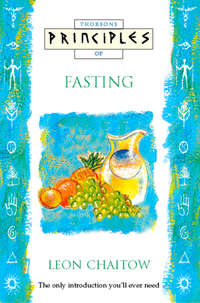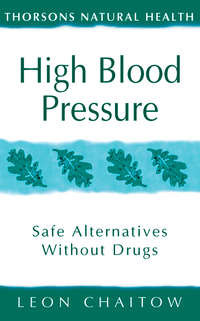
Полная версия
Relaxation and Meditation Techniques: A Complete Stress-proofing System


Copyright
Thorsons
An Imprint of HarperCollinsPublishers
1 London Bridge Street
London SE1 9GF
www.harpercollins.co.uk
First published by Thorsons 1983
© Leon Chaitow 1983
All rights reserved under International and Pan-American Copyright Conventions. By payment of the required fees, you have been granted the nonexclusive, nontransferable right to access and read the text of this e-book on-screen. No part of this text may be reproduced, transmitted, downloaded, decompiled, reverse-engineered, or stored in or introduced into any information storage and retrieval system, in any form or by any means, whether electronic or mechanical, now known or hereafter invented, without the express written permission of HarperCollins e-books.
HarperCollinsPublishers has made every reasonable effort to ensure that any picture content and written content in this ebook has been included or removed in accordance with the contractual and technological constraints in operation at the time of publication.
Source ISBN: 9780722508654
Ebook Edition © JULY 2016 ISBN: 9780008214975
Version: 2016-08-04
RELAXATION AND MEDITATION TECHNIQUES
A practical guide to overcoming stress and common ailments through relaxation therapies, including visualization, breathing and healing techniques.
Dedication
To my darling wife, Alkmini, whose help and support made
the writing of this book possible.
Contents
Cover
Title Page
Copyright
Dedication
Introduction
Chapter
1. The Causes and Nature of Stress
2. The Physical Effects of Stress
3. Assessing Your Stress
4. Starting to Stress-proof Yourself
5. Relaxation Exercises
6. Additional Relaxation Methods
7. Meditation
8. Using the Power of the Mind for Healing
Keep Reading
Acknowledgements
About the Author
Other Books By
About the Publisher
Introduction
The aim of this book is to present a choice of methods, the application of which will better enable you to cope with stress. Stress itself therefore needs to be looked at, for it comes in a variety of shades and shapes. Once we understand the diverse nature of stress, and also its possible ramifications in terms of ill health and disturbed function, the importance of these methods will become apparent
Watches used to be described as ‘waterproof’. This has now been altered to ‘water-resistant’ where applicable. In stating the degree of resistance, the manufacturers have, of course, to pay due attention to both the nature of the hazard and the properties and qualities of the instrument. Such aspects would include consideration of the variations in water (salt, fresh, acid, alkaline, etc.) and also the materials and design of the watch. Finally, the watch is guaranteed resistant to water up to a certain depth (30 metres, 50 metres etc.). There are other hazards facing wrist watches, such as shock, intense heat, cold, magnetism etc. In the same way, the human condition faces a range of stress factors and it is not possible to ‘stress-proof’ anyone, absolutely. However, stress-resistance can be increased and, as in the case of the watch, attention needs to be paid to both the stress factors and all their variables as well as the instrument at risk, the human machine. The aim is therefore not to eliminate stress, but to modify it where possible and to encourage appropriate responses to it.
Health and ill health are the result of the complex interrelationship between the unique individual and the challenges and stresses of his particular internal and external environment. Stress can be a self-produced phenomenon (e.g. anger, fear) or it can be externally generated (e.g. job insecurity, an unstable marriage etc.). More usually, the stress-picture is an amalgam of internally and externally originating factors. Attitudes, beliefs, behaviour patterns, personality traits and deeply entrenched habits of thought may all be partly responsible, and several ways of examining and modifying such factors will be discussed. The importance of correct nutrition, sufficient exercise and rest, as well as such factors as adequate access to full spectrum light (daylight) will be touched on in as much as they relate to stress reduction and to our aim of stress-proofing the body. These areas are important, but the main point of this book is to show that there are defences which can be erected against stress whatever form it takes and that, by the regular application of these methods, great benefit can be derived in terms of health and well-being. We must certainly aim at reducing stress, but must also increase our resistance to it and learn to counteract its effects.
In brief, therefore, we shall examine some of the major causes of stress. This will be followed by a look at the physiological and pathological effects which prolonged stress can produce. Reference will be made to the relationship that exists between all changes in lifestyle (marriage, divorce, job changes etc.) and subsequent ill health. Knowing what constitutes stress can certainly alert us as to desirable evasive action and some consideration will be given to the roles in stress reduction of diet, exercise, rest, light etc., as well as positive suggestions relating to the changing of attitudes and coming to an understanding of those aspects of stress which are within our conscious control.
Finally, a number of different relaxation methods, as well as a selection of meditation techniques will be presented, together with a resumé of current thinking on the use of mind/body therapies, such as visualization, which stress the power of the mind in promoting good health. The power of the mind to create a disturbed physiology and actual disease, is matched by its equal ability to create health and harmony. A variety of techniques exist in this field, some more suited to a particular person than others. The main aim of this book is to enable the reader to find those methods that best suit him or her and to explain how important their regular use is in regaining and maintaining health. Whether active or passive relaxation methods are employed, or whether meditation alone is found to produce the desired results, is immaterial. What matters is that we learn to harness the mind’s latent force towards positive rather than negative goals, and that the mind/body complex is insulated, as far as possible, from those internally and externally generated stresses which, left unchecked, will first weaken, then cripple and finally destroy the body.
Health and disease and all the grey area between, are states which reflect the ability, or otherwise, of the body to maintain equilibrium (known as homeostasis) in the face of a host of environmental threats and hazards. At any given time, the individual represents a culmination of all that has been inherited, and all that has been acquired and developed up to that moment. The degrees of susceptibility and of resistance that the body can demonstrate, will be absolutely unique to him. With so many variables, it should be obvious that no one method, system or prescription can apply to everyone, even if similar outward manifestations of ill health are evident. For this reason, less emphasis should be placed on signs, symptoms and outward manifestations of ill health; whilst these are important, especially to the individual, they do not indicate more than the particular manner in which his organism has responded to those factors which have threatened him. The same symptoms (e.g. headache) can result from a variety of causes. The same apparent cause (e.g. anxiety regarding work) can produce quite different symptoms, say insomnia in one person, palpitations in another and headaches in a third.
Treatment of the symptoms can never bring more than short-term benefit. To remove the symptom and ignore the cause is patently wrong, for that or another symptom will surely manifest itself sooner or later. Only by improving the general level of function of the total organism and by removing, where possible, the causes of the condition, can a successful outcome be anticipated. Since causes of anxiety are often outside the control of the individual (‘Will there be a third World War?’; ‘Will the factory close down?’; ‘How will I pay my bills?’, etc.), it is necessary to provide ways of altering the ways in which such problems are viewed. In addition, techniques are necessary whereby, even if such stress remains to some extent constant, the individual can nullify and counteract its ill effects by positive action. This is where relaxation, meditation and other exercises of the mind come in.
The individuality of each person must be recognized; this leads to a realization that the particular factors which enable successful adaptation to the environment will vary. Stress-proofing involves gaining understanding and insight into the nature of the problems of stress, as well as a determination to make changes, alterations, modifications and efforts in accordance with this knowledge. Through this apparent maze, I would urge the reader to hold fast to one concrete thought: given the chance, the body is a self-healing, self-repairing and self-regenerating organism. The aim is to give it that chance, and at the same time to erect barriers which will provide protection against future hazards.
Конец ознакомительного фрагмента.
Текст предоставлен ООО «ЛитРес».
Прочитайте эту книгу целиком, купив полную легальную версию на ЛитРес.
Безопасно оплатить книгу можно банковской картой Visa, MasterCard, Maestro, со счета мобильного телефона, с платежного терминала, в салоне МТС или Связной, через PayPal, WebMoney, Яндекс.Деньги, QIWI Кошелек, бонусными картами или другим удобным Вам способом.









